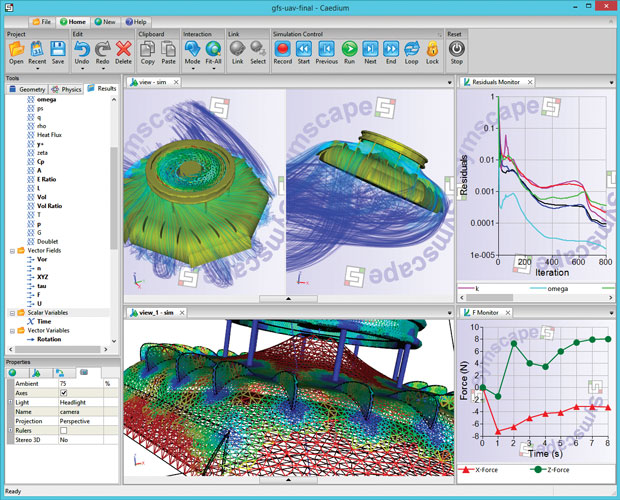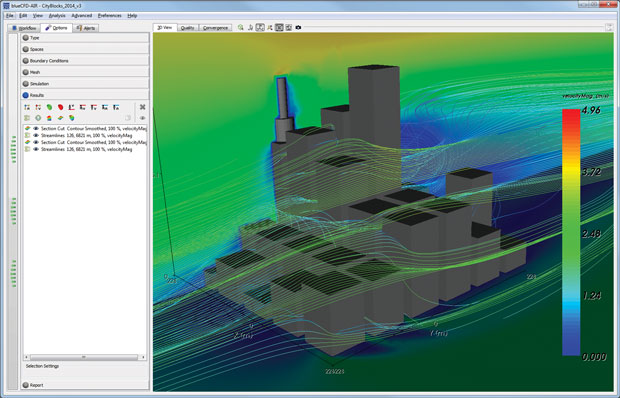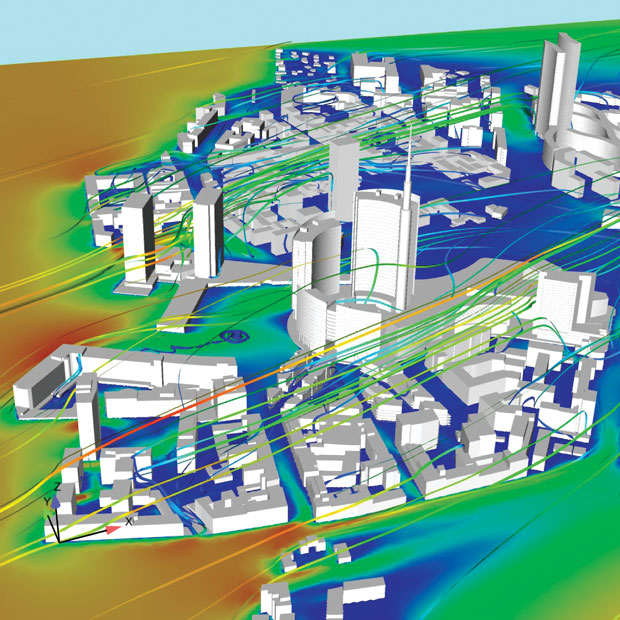
User interface example with CFD analysis results on a UAV, performed with Symscape Caedium CFD software. Image courtesy of Symscape.
Latest News
July 1, 2015
I’m sitting with some other engineers and we start talking about computational fluid dynamics (CFD) software (yeah, certified geeks). The question comes up, what’s a good CFD package for regular non-Megabucks engineers to use? What if you just do one kind of task over and over? What if you want a general purpose package without major prep-time effort?
Mentor Graphics must have been listening in on this talk. The company has a white paper called “The Third Wave of CFD,” authored by Ivo Weinhold and John Parry of Mentor Graphics Germany and U.K., respectively, that states: “The CFD software market is becoming more diverse ... but all have one thing in common: the industrial user, with his or her need for easy-to-use, task-oriented, automated, reliable, efficient and readily-available CFD software as an indispensable tool for digital prototyping, is the focus.” The industrial user, it said, not the analyst.
Whether you need external flow capabilities but not internal, only design exhaust systems not sewer systems (or vice versa), or just want a general purpose CFD code without the demands of classic meshing, one of the numerous lesser known CFD packages could be just right for you. Many are purpose-built to do a few things well, while others take advantage of open-source software.
Best Kept Secrets?
Navier-Stokes, Euler, Boltzmann and other equations can be used to describe the behavior of fluid flow, but in the early days, solving those equations was limited by processing and memory resources. A handful of approaches worked, so people stuck with them. Today’s parallel processors, expanded memory structures and improved graphics have allowed developers to revisit some of the older intractable solutions. Add in more pre-processing approaches and customized user-interface options, and you’ll find a broad range of CFD analysis choices.
Convergent Science Inc. tackles the challenge of mesh generation head-on. Starting back in 1997, the company developed CONVERGE, a CFD code that uses Adaptive Mesh Refinement to completely eliminate the user time needed to generate a mesh, refine the mesh where it is needed (no need to judge where to increase density) or adapt to moving boundaries—all these steps are automatic. For user convenience, CONVERGE is available for desktop download or in the cloud on a pay-per-use basis, tackling everything from fuel-injection systems to turbines to vascular systems to sports applications. With special emphasis on multiphase liquid/gas analysis, liquid atomization and drop formation, CONVERGE handles large eddy simulation (LES) and Reynolds-Averaged Navier-Stokes (RANS) turbulence models as well as conjugate heat-transfer analysis of solids with fluids.What if your CFD project involves system-level design rather than components? The Flownex Simulation Environment from Flownex (South Africa) distributed in the U.S. by Phoenix Analysis and Design Technologies Inc. (PADT Inc.) lets users examine extensive sets of parameter variations in systems and subsystems that depend greatly on fluid-thermal effects. Flownex lets users enter property values or choose from a library of reduced order models including low-speed turbines, valves, pipes, combustion chambers and electrical controls. Users drag and drop these component models into a system diagram, easily creating a network that is evaluated using the Implicit Pressure Correction Method.
 Post-processing of a six-by-six city-block example, for studying the airflow over, around and between buildings. Geometry analyzed and viewed with blueCAPE-AIR from blueCAPE; the software is based on a port of OpenFOAM technology. Image courtesy of blueCAPE.
Post-processing of a six-by-six city-block example, for studying the airflow over, around and between buildings. Geometry analyzed and viewed with blueCAPE-AIR from blueCAPE; the software is based on a port of OpenFOAM technology. Image courtesy of blueCAPE.“Flownex was the perfect solution for PADT to offer to clients who knew component but not system behavior. The software models thermal-fluid systems, solving for temperature, pressure and velocity (plus derived values),” says Eric Miller, co-owner and consultant for PADT Inc. Various Flownex modules handle two-phase fluids, gas mixtures, slurries, incondensable mixtures, transient behavior, optimization and more.
Hanley Innovations also took customer needs directly into account when it developed Stallion 3D and other CFD packages. “I had a strong desire for my customers to spend their time actually working on solutions for their projects rather than sacrificing precious time honing their CFD gridding skills,” said Patrick Hanley, president of Hanley Innovations.
With Stallion 3D, users import a CAD model leaving all logos and other “nuts and bolts” details intact, saving time (the unique Hanley Innovations Surface Treatment (HIST) performs automatic grid generation) and supporting more accurate analyses. Users can download the software in the morning and get a complete analysis by lunchtime.
Stallion 3D solves the full 3D Euler or Navier-Stokes equations for aerodynamics and includes pre- and post-processing functions. Applications include aircraft wings, automotive spoilers and sailboat keels. Customers in niche fields such as UAV (unmanned aerial vehicles) design can also use the Hanley 2D MultiSurface and MultiElement packages to determine initial shapes. “An engineer can analyze up to 30 airflows simultaneously on a tablet or laptop,” says Hanley.
KARALIT software from Italy may not be a familiar name in the U.S., but its roots in CFD go back more than 20 years. The company website offers extensive FAQs that are highly useful because the software operates in stark contrast to traditional methods. KARALIT CFD is based on a time-saving immersed boundary (IB) approach, where the imported CAD geometry is directly immersed into Cartesian grids. This eliminates the need to create a mesh and maintains cell integrity. Local grid refinement is done automatically. Analysis handles turbulence, porosity, heat transfer, rotating flows, all ranges of Reynolds numbers and more.
 Airflow around city buildings in Milan, analyzed with Karalit CFD software. Image courtesy of Karalit.
Airflow around city buildings in Milan, analyzed with Karalit CFD software. Image courtesy of Karalit.In a workflow that KARALIT calls Direct CFD, users set up simulations by entering parameters in simple templates called apps. Current automated apps include Wind Tunnel, External Flow, Building Flow and Internal Flow. KARALIT is offering a webinar on July 22 to show the benefits of its Direct CFD approach.
Metacomp Technologies, founded in 1994, offers three base versions of its CFD++ software: CP (compressible perfect gas), CR (compressible real gas) and IF (incompressible fluid and compressible liquids). Each package solves unsteady, steady, inviscid, laminar and turbulent flows, and works with CFD++ add-on modules that address moving mesh and rigid body dynamics. The platforms also support multi-phase including dispersed phase (Eulerian and Lagrangian treatment), mixture models and interface tracking, non-equilibrium chemistry and thermal non-equilibrium conditions. Tightly coupled rigid-body and fluid dynamics produce accurate transient responses for applications ranging from turbomachinery to launch-vehicle plume computations.
CFD++ software is mesh neutral and offers an easy-to-use interface for problem setup. Metacomp Technologies actively supports design engineers by creating application-specific front ends: “CFD++ already has wizards to help users work on different problem classes (e.g., external aerospace or automotive aerodynamics, reacting flows) and it is very easy to embed in customers’ workflow,” says Sukumar Chakravarthy, president at Metacomp Technologies.
Stepping aside from traditional CFD approaches is Next Limit Technologies of Spain with its meshless, XFlow CFD software. Since its first release in 2011, XFlow has used a particle-based kinetic algorithm to efficiently solve Boltzmann’s non-equilibrium equations. The latter are known to more accurately account for highly turbulent (large eddy) fluid effects than RANS calculations, but prior to parallel processing were difficult to solve in a timely manner.
“To set up the simulations, the user needs only import watertight geometry and then specify simulation parameters. There is no time wasted actually meshing the volumetric fluid domain,” says Zaki Abiza, XFlow application engineer, Next Limit Technologies.
As a result, the complexity of the surface geometry is not a limiting factor. XFlow includes setup, solution and post-processing for such applications as external/internal aerodynamics, free-surface analysis, multiphase analysis and real moving parts with up to six degrees of freedom (DOF). The package runs well on both distributed- and shared-memory parallel processing systems.
Open Source Approaches
What about using open source code? Commercial products based on the OpenFOAM (Open Field Operation and Manipulation) technology toolbox offer the CFD solvers you expect plus intriguing extensions and user-friendly capabilities. OpenFOAM software is a free, open source CFD software package licensed and distributed by the OpenFOAM Foundation.The Foundation’s Board of Directors includes Henry Weller and Chris Greenshields, who originally founded OpenCFD Ltd. to develop and release OpenFOAM. OpenCFD Ltd. was acquired in 2011 by Silicon Graphics International (SGI), when the OpenFOAM copyright was transferred to the OpenFOAM Foundation to ensure its open source status; in 2012 ESI Group acquired OpenCFD Ltd from SGI. In 2014, Weller and Greenshields left ESI Group and founded CFD Direct to continue the development and management of OpenFOAM, on behalf of the OpenFOAM Foundation. Other companies develop commercial, proprietary front-end interfaces to OpenFOAM software.
Caedium products from Symscape address the company’s core mission of providing “computational fluid dynamics software for all.” From the free interactive Caedium Viewer to add-ons such as Caedium RANS Flow, all aspects of analysis are performed within a single, unified simulation environment.
 User interface example with CFD analysis results on a UAV, performed with Symscape Caedium CFD software. Image courtesy of Symscape.
User interface example with CFD analysis results on a UAV, performed with Symscape Caedium CFD software. Image courtesy of Symscape.“This unified environment means that CAD, meshing, physics setup, solution running/steering, and post-processing are all in the same application and fully integrated. Each Caedium add-on seamlessly integrates into this simulation environment, so you only need to learn a few basic operations (drag and drop, tools, properties, etc.) and you are immediately productive,” says Richard Smith, principal, Symscape.
Built around OpenFOAM technology, the Caedium RANS Flow product includes all the traditional features you’d expect, from various flow types (laminar, turbulent, steady, unsteady, incompressible, compressible and transonic) to multiphase behavior, rotating machinery, and porous media. This package and all other Caedium add-ons, including the Caedium Transient, Panel Flow, Builder (geometry) and Viz Export programs, is available as a 30-day free trial for Linux, Windows and Mac OS X systems.Another engineering group, blueCAPE of Portugal, is proving that open source solutions can be your best fit for CFD analysis work. The company’s blueCFD-Core product offers a high-quality build of OpenFOAM technology for convenient Windows 64-bit implementations. First released in 2009, this port offers a range of useful attributes, from three MPI (message-passing interface) toolboxes for multi-core/multi-machine operation to a “portable” function that allows copying the installed blueCFD-Core onto a USB drive for use on other Windows machines.
Application-specific versions are coming on the market, starting with the current blueCFD-AIR for flow around structures. Bruno Santos, blueCAPE senior R&D engineer, says this package simulates airflow both inside and outside of buildings and involves much more than just a custom GUI (graphical user interface). “Its primary goal,” says Santos, “is to make it easier to apply CFD, without the need for a PhD. We’re also developing blueCFD-Kernel, essentially middleware software that can aid software developers.”
A third player in this field is TotalSim USA, whose aerodynamics experts have the tagline: “We live and breathe OpenFOAM.” Although the company does work with some traditional CFD packages, it specializes in creating custom CFD solutions that allow OpenFOAM technology to be better used as a robust engineering tool.
“One interesting aspect of our business is the development of CFD Vertical Applications. These apps are typically tailored to replicate, in modeling and simulation, a specific testing task a company will use in their design cycle,” says Raymond Leto, president, TotalSIM. In one app example, a CFD flow-predictor (accessed through a simple Web portal) helps truck designers readily evaluate the aerodynamic effect of vehicle add-ons.
Of course, CFD needs are a moving target. The more well-known CFD and multiphysics software packages provide more tools engineers can use to simulate more phenomena—with service and support that is hard for smaller vendors and the open-source community to match. What you’re tasked with simulating today might not be what you need to simulate tomorrow, and more complete CFD suites provide an easy path to follow as users scale up their simulation efforts. Being able to do more types of simulation from a familiar environment can provide a huge advantage in time savings because you don’t have to learn a new user interface each time. Having the ability to quickly run different CFD simulations can also help you uncover issues you might not have found otherwise.
Perhaps the Mentor Graphics white paper says it best: “The software will need to adapt to the working environment of the user, his needs and his individual intellectual capacity, and not vice versa.” It’s nice to see all the ways that is happening now.
Editor’s note: The original version of this article incorrectly stated the ownership and development of OpenFOAM software, a free, open source CFD software package licensed and distributed by the OpenFOAM Foundation. The Foundation’s Board of Directors includes Henry Weller and Chris Greenshields, who originally founded OpenCFD Ltd. to develop and release OpenFOAM. OpenCFD Ltd. was acquired in 2011 by Silicon Graphics International (SGI), when the OpenFOAM copyright was transferred to the OpenFOAM Foundation to ensure its open source status; in 2012 ESI Group acquired OpenCFD Ltd from SGI. In 2014, Weller and Greenshields left ESI Group and founded CFD Direct to continue the development and management of OpenFOAM, on behalf of the OpenFOAM Foundation. Other companies develop commercial, proprietary front-end interfaces to OpenFOAM software. The article has been updated to reflect the corrected information.
More Info
Subscribe to our FREE magazine, FREE email newsletters or both!
Latest News
About the Author
Pamela Waterman worked as Digital Engineering’s contributing editor for two decades. Contact her via .(JavaScript must be enabled to view this email address).
Follow DE






